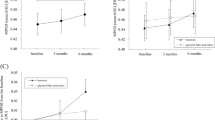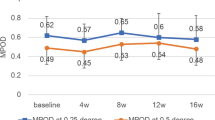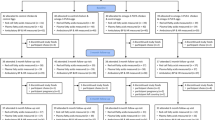Abstract
Background/Objective:
Lutein is a xanthophyll found in the chloroplasts of dark green leafy vegetables, chromoplasts of fruits, and egg yolk. Dietary, serum and macular lutein are inversely related to the risk of age-related macular degeneration. Although the lutein from egg is known to be more bioavailable than that from spinach, not much is known about lutein bioavailability from n-3 fatty acid enriched eggs and organic eggs, both of which are increasingly available to consumers.
Subjects/Methods:
We determined the effects of feeding n-3 fatty acid-enriched eggs and organic eggs on serum lutein, zeaxanthin and β-carotene in 20 healthy lacto-ovo-vegetarian (LOV) adults using a single-blind, randomized, crossover study design with a 4-week washout between treatments: six organic eggs or six n-3 fatty acid enriched eggs per week or no egg control for 8weeks each.
Results:
Serum lutein was significantly higher in both egg treatments (P<0.009) compared with the control, but was not different between the two egg treatments. Serum β-carotene was also higher in the egg groups compared with control but only approached significance (P=0.066). Serum zeaxanthin increased in both egg treatments compared with control but did not reach statistical significance (P=0.139).
Conclusion:
n-3 fatty acid enriched eggs and organic eggs may both significantly increase serum lutein in healthy LOV consuming a predominately plant-based diet.
This is a preview of subscription content, access via your institution
Access options
Subscribe to this journal
Receive 12 print issues and online access
$259.00 per year
only $21.58 per issue
Buy this article
- Purchase on Springer Link
- Instant access to full article PDF
Prices may be subject to local taxes which are calculated during checkout
Similar content being viewed by others
References
Anderson HA, Imm P, Knobeloch L, Turyk M, Mathew J, Buelow C et al (2008). Polybrominated diphenyl ethers (PBDE) in serum: findings from a US cohort of consumers of sport-caught fish. Chemosphere 73, 187–194.
Bone R, Landrum J, Guerra L, Ruiz C (2003). Lutein and zeaxanthin dietary supplements raise macular pigment density and serum concentrations of these carotenoids in humans. J Nutr 133, 992–998.
Chan C, Leung I, Lam K, Tso M (1998). The occurrence of retinol and carotenoids in human subretinal fluid. Curr Eye Res 17, 890–895.
Chung H, Rasmussen H, Johnson E (2004). Lutein bioavailability is higher from lutein-enriched eggs than from supplements and spinach in men. J Nutr 134, 1887–1893.
Clark R, Herron K, Waters D, Fernandez M (2006). Hypo- and hyperresponse to egg cholesterol predicts plasma lutein and β-carotene concentrations in men and women. J Nutr 136, 601–607.
Greene CM, Waters D, Clark RM, Contois JH, Fernandez ML (2006). Plasma LDL and HDL characteristics and carotenoid content are positively influenced by egg consumption in an elderly population. Nutr Metab (Lond) 3, 6.
Goodrow EF, Wilson TA, Houde SC, Vishwanathan R, Scollin PA, Handelman G et al. (2006). Consumption of one egg per day increases serum lutein and zeaxanthin concentrations in older adults without altering serum lipid and lipoprotein cholesterol concentrations. J Nutr 136, 2519–2524.
Guiliano A, Matzner M, Canfield L (1993). Assessing variability in quantitation of carotenoids in human plasma: variance component model. In: Packer L (ed). Methods in Enzymology. Academic Press: San Diego, CA. pp 94–101.
Handelman G, Nightengale Z, Lichtenstein A, Schaefer E, Blumberg J (1999). Lutein and zeaxanthin concentrations in plasma after dietary supplementation with egg yolk. Am J Clin Nutr 70, 247–251.
Herron K, McGrane M, Waters D, Lofren I, Clark R, Ordovas J et al. (2006). The ABCG5 polymorphism contributes to individual responses to dietary cholesterol and carotenoids in eggs. Am Soc Nutr 136, 1161–1165.
Johnson EJ, Chung HY, Caldarella SM, Snodderly DM (2008). The influence of supplemental lutein and docosahexaenoic acid on serum, lipoproteins, and macular pigmentation. Am J Clin Nutr 87, 1521–1529.
Kris-Etherton PM, Taylor DS, Yu-Poth S, Huth P, Moriarty K, Fishell V et al. (2000). Polyunsaturated fatty acids in the food chain in the United States. Am J Clin Nutr 71, 179S–188S.
Lienau A, Glaser T, Tang G, Dolnikowski G, Grusak M, Albert K (2003). Bioavailability of lutein in humans from intrinsically labeled vegetables determined by LC-APCI-MS. J Nutr Biochem 11, 663–670.
Mozaffarian D, Rimm EB (2006). Fish intake, contaminants, and human health: evaluating the risks and the benefits. J Am Med Assoc 296, 1885–1899.
Nolan JM, Stack J, O'Connell E, Beatty S (2007). The relationships between macular pigment optical density and its constituent carotenoids in diet and serum. Invest Ophthalmol Vis Sci 48, 571–582.
Oberholtzer L, Greene C, Lopez E (2006). Organic poultry and eggs capture high price premiums and growing share of specialty market. December 2006. Report No. LDP-M-150-01. Sponsored by the Economic Research Service/USDA.
Olmedilla B, Granado F, Blanco I, Vaquero M (2003). Lutein, but not alpha-tocopherol, supplementation improves visual function in patients with age-related cataracts: a 2-y double-blind, placebo-controlled pilot study. J Nutr 19, 21–24.
Rapp L, Maple S, Choi J (2000). Lutein and zeaxanthin concentrations in rod outer segment membranes from perifoveal and peripheral human retina. Invest Ophthalmol Vis Sci 41, 1200–1209.
Rock CL, Jahnke MG, Gorenflo DW, Swartz R, Messana JM (1997). Racial group differences in plasma concentration of antioxidant vitamins and carotenoids in hemodialysis patients. Am J Clin Nutr 65, 844–850.
Samman S, Kung FP, Carter LM, Foster MJ, Ahmad ZI (2009). Fatty acid composition of certified organic, conventional and omega-3 eggs. Food Chem 116, 911–914.
Surai P, MacPherson A, Speake B, Sparks N (2000). Designer egg evaluation in a controlled trial. Eur J Clin Nutr 54, 298–305.
Tyssandier V, Reboul E, Dumas JF, Bouteloup-Demange C, Armand M, Marcand J et al. (2003). Processing of vegetable-borne carotenoids in the human stomach and duodenum. Am J Physiol Gastrointest Liver Physiol 284, G913–G923.
U.S. Department of Agriculture, Agricultural Research Service (2008). USDA National Nutrient Database for Standard Reference, Release 20. Nutrient Data Laboratory Home Page. http://www.ars.usda.gov/ba/bhnrc/ndl. (accessed 15 September 2009).
van Het Hof K, West C, Weststrate J, Hautvast J (2000). Dietary factors that affect the bioavailability of carotenoids. J Nutr 130, 503–506.
Wenzel AL, Gerwick C, Barbato D, Nicolosi RJ, Handelman GJ, Curran-Celentano J (2006). A 12-week egg intervention increases serum zeaxanthin and macular pigment optical density in women. J Nutr 136, 2568–2573.
Acknowledgements
We would like to extend special thanks to Lisa Forde-Griffith for her technical laboratory assistance, the American Egg Board for their Graduate Fellowship Grant, the California State Polytechnic University for the Agriculture Research Initiative, and Chino Valley Ranchers (Irvine, CA) for supplying the eggs at no cost to the study.
Author information
Authors and Affiliations
Corresponding author
Ethics declarations
Competing interests
The authors declare no conflict of interest.
Rights and permissions
About this article
Cite this article
Burns-Whitmore, B., Haddad, E., Sabaté, J. et al. Effect of n-3 fatty acid enriched eggs and organic eggs on serum lutein in free-living lacto-ovo vegetarians. Eur J Clin Nutr 64, 1332–1337 (2010). https://doi.org/10.1038/ejcn.2010.140
Received:
Revised:
Accepted:
Published:
Issue Date:
DOI: https://doi.org/10.1038/ejcn.2010.140
Keywords
This article is cited by
-
Biomarker of food intake for assessing the consumption of dairy and egg products
Genes & Nutrition (2018)
-
A pilot comparison of phospolipidated lutein to conventional lutein for effects on plasma lutein concentrations in adult people
Nutrition Journal (2015)
-
Effects of supplementing n-3 fatty acid enriched eggs and walnuts on cardiovascular disease risk markers in healthy free-living lacto-ovo-vegetarians: a randomized, crossover, free-living intervention study
Nutrition Journal (2014)
-
Back-transformation of treatment differences—an approximate method
European Journal of Clinical Nutrition (2014)



